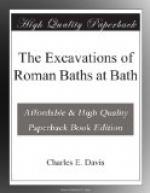overflowing with hot water. From this a channel
is visible in the pavement, in a line of direction
eastward, conveying the water to Lucas’s Bath’
(pp. 20-21). Thus then in 1763 (1) the north
and south walls of the great Roman Bath had been traced
6ft. or 8ft. west of Lucas’s Bath. (2) Furthermore,
starting from the centre of the west side of Lucas’s
Bath, a line had been traced to the east steps of
the great Roman Bath. These are plain historical
facts, open to everyone who will look into the plans
of our baths, as given by Sutherland in 1763, and
by Prebendary Scarth in his ‘Aquae Solis’
in 1864. But our City Architect has been charged
with suppressing these facts for his own glorification.
Now, Sir, I think no unprejudiced man, who has heard
Major Davis’s addresses and read his books,
can justly bring this charge. If I mistake not,
he fairly stated the case in 1880, both in his address
before the Society of Antiquaries, and in his lecture
at the Bath Literary Institution. He has most
certainly concealed nothing in his published works
’The Bathes of Bathe’s Ayde’ and
‘Guide to the Roman Baths.’ In the
former work he says (p. 81), ’Dr. Sutherland
indicates a large bath westward of that which had
been discovered in his time, in fact there can be
little doubt that the steps at the eastward end of
a great bath had then been found;’ in the latter,
whilst alluding to the published plans of Sutherland,
he says (p. 10), ’These plans indicate a large
bath westward of that discovered in 1754 (? 1755),
in fact the eastward steps of a bath had then been
found.’ Here then is a full and candid
admission of all the facts known about the great Roman
Bath in the middle of the last century; and this anyone
can see by reference to the map in Prebendary Scarth’s
’Aquae Solis’—the diagram (copied
from Spry) there being almost similar to Sutherland’s
conjectural plan of the baths, except that the section
of Lucas’s Bath, correctly represented in Sutherland’s
map is figured upside-down by Spry and Scarth.
It is quite clear what Sutherland knew of the great
Roman Bath; it is equally clear that when he proceeded,
on the strength of his very limited observations,
to draw a conjectural plan of the whole bath, he fell
into absolute errors, such as, commonly enough, spring
out of hasty generalisations based on scanty data.
Thus, he gives the dimensions of the enclosure of
the great bath as 96ft. by 68ft.; whereas, as a matter
of fact, they are 111ft. by 68ft. How is this
discrepancy to be explained? ‘A Citizen’
in your last weekly issue, says ’The alleged
discrepancies in the measurements, which Mr. Davis
has used to prove his case, are but the differentiations
of the external measurements with the sinuous subterranean
windings.’ These are indeed brave words,
indulged in rather to diminish Major Davis credit
than to rescue Sutherland; but a truer explanation
of the real discrepancies stares any man in the face
who will open Dr. Sutherland’s work. There
is no occasion to be wise beyond what is written:




